Welcome to the Vienna Symphonic Library’s series of Synchron Instruments! The instruments were recorded at Stage A, the main hall of Vienna’s revitalized Vienna Synchron Stage. The recordings were executed using an expansive, phase-controlled multi-microphone set-up, capturing string effects played in a scoring stage with exceptional acoustics, now ready to be used in your studio. This document will provide you with the information you need to use the Library with our Vienna Synchron Player.

All the instruments were recorded using 20 microphones, subdivided into 11 sections. The Standard Library includes 4 of these sections (as well as a RAM-friendly Room Mix section composed of merged samples from the individual positions), allowing you to integrate instruments recorded with a stereo Decca tree into your projects using the Vienna Synchron player or our mixing hosts Vienna Ensemble and Vienna Ensemble Pro. Adding the Extended Library and thus getting the Full Library expands your possibilities to 5.1 surround and Auro 3D 9.1, with the additional option of High Stereo and Surround microphones to expand your sound possibilities even further.
Microphone positions
Standard Library
00. Room Mix – Stereo
01. Close Mic 1 (Tube) – Mono
04. Mid Layer Mic 1 – Stereo (L/R)
07. Main/Room Mic – Decca Tree Stereo (L/R)
08. Main/Room Mic – Decca Tree Mono (Center)
Extended Library
02. Close Mic 2 (Ribbon) – Mono
03. Close Mic 3 (Condenser) – Stereo (L/R)
05. Mid Layer Mic 2 – Stereo (L/R)
06. Mid Layer Mic 3 (Ribbon) – Stereo (L/R)
09. Main Surround – Stereo (L/R)
10. High Stereo (3D) – Stereo (L/R)
11. High Surround (3D) – Stereo (L/R)
Patches can be used to build your own custom Presets and adapt the Synchron Libraries to your specific requirements. For further information on constructing Presets, please see the Synchron Player manual.
Auro 3D is an immersive audio technology that allows for three-dimensional sound perception. The Belgian company Auro Technologies developed this technology based on a special speaker configuration, adding four additional speakers to a 5.1 surround configuration. These speakers (so-called “Heights”) are situated above the front and surround speakers and generate acoustic reflections that are perceived naturally due to the fact that sounds originate from around as well as from above the listener. Thanks to the comprehensive selection of discrete audio channels with the Full Library, you may mix your instruments in Auro 3D as well as in Dolby Atmos.
The collection’s instruments provide two different kinds of Presets, accessible by clicking on the icons “Flow” resp. “Precision” in the Synchron Player’s top bar. Flow Presets offer an intuitive, graphic approach to the library’s contents, with instrument, articulation, and sound parameters displayed in a single window.
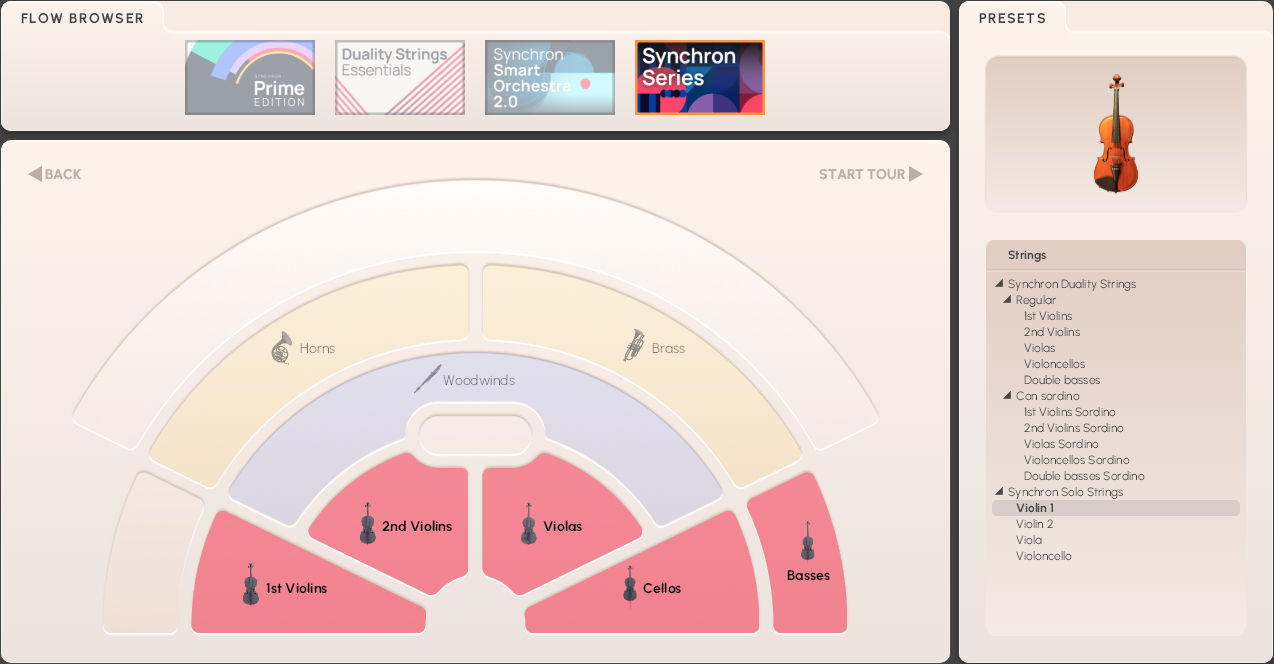
Precision Presets are what you already know if you own other VSL libraries. They allow you to explore the depths of the library, adjusting and tweaking parameters as you see fit.
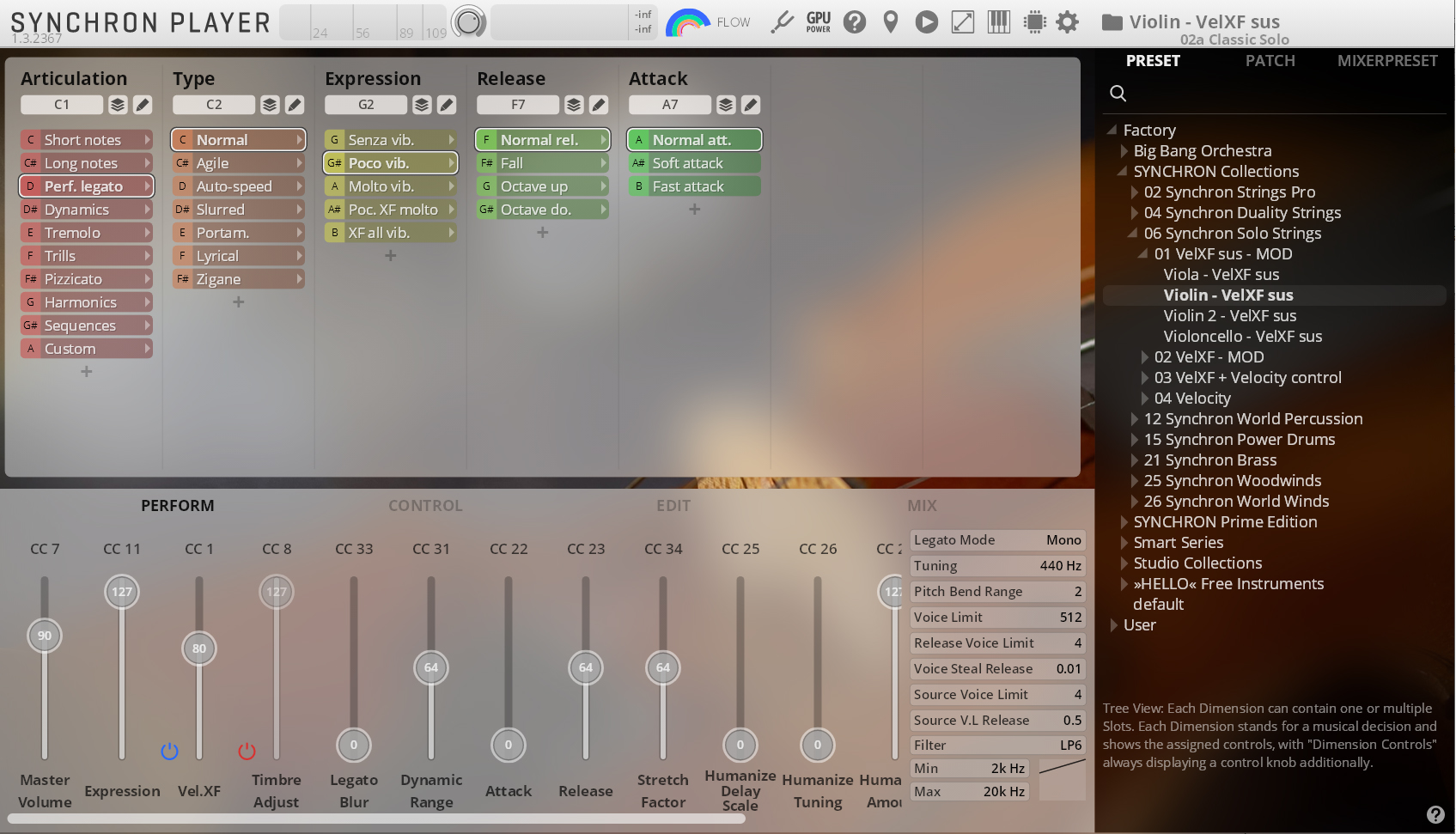
For each ensemble, there are a number of Mixer Presets that depict different recording situations. The basic Mixer Presets in this Collection are Close Solo/Center/First Chair, Classic Solo/Center/First Chair, Wide, Distant, Ambience, Lush, and Lush Long. These are available in stereo versions for Room-Mix, Standard and Full, as well as in Decca Tree Multi Mic and Surround Presets. Moreover, there is a Special category for the Full Library.
By default the classic room mixes are loaded which include the Standard Library microphone positions “Room Mix”, “Tube” and “Mid”. These are balanced in the stereo field to represent the respective instrument’s position in the Synchron Stage set-up.
Flow Presets give you instant access to the most important parameters of an instrument, its articulations, and general sound settings in the Synchron Player’s Flow view. The display is subdivided accordingly, with the graphic keyboard underneath. On the Flow Browser page, you can click on START TOUR to step through explanations of the different Flow elements and parameters as shown below.
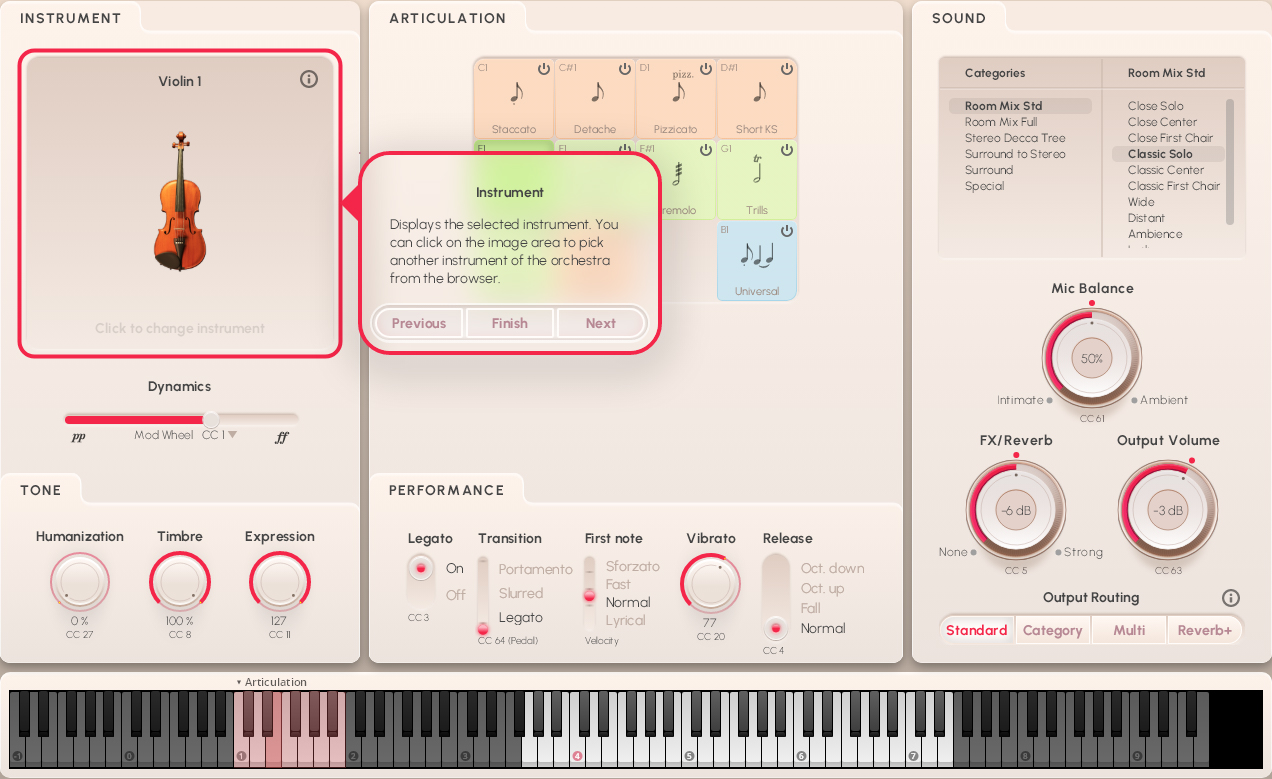
The Instrument section shows a symbolic image of the selected Instrument, headed by the name of the loaded Preset. You can return to the Flow Browser to select another instrument by clicking on the field. Clicking on the Info circle will connect you to the Vienna Academy, our instrumentology site.
The Dynamics fader under the instrument is set to the modwheel (MIDI CC1) or keystroke velocity by default – with the long notes used in the example below, it is the modwheel, meaning that you can influence the volume of a note being played by changing the controller value. You could also set it to a breath controller (MIDI CC2), leaving your hand free for other stuff. The staccatos, e.g., are set to keystroke velocity, as changing the volume of short notes while they are sounding hardly makes sense.
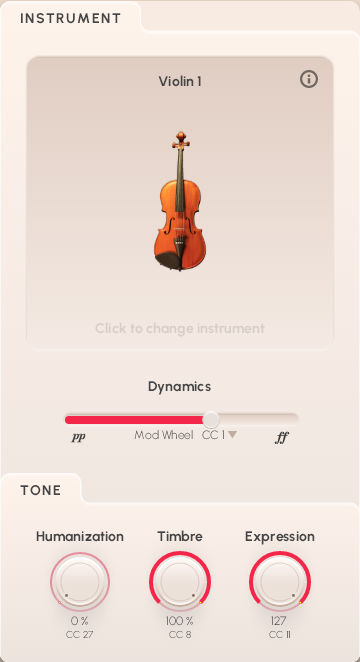
In the Tone field, you get access to three other items which may be an important factor in making your piece sound truly alive:
Humanization (MIDI CC27) lets you determine the percentage of not being exactly on time – a kind of counter-quantization that introduces an element of necessary imperfection.
Timbre (MIDI CC8) affects the tone of the instrument, making it sound brighter or darker.
Expression (MIDI CC11) is an additional volume control defining a percentage of CC7 (volume), and can be used for automation.
The Articulation pane holds all the samples, so to speak. In the upper field, you see the possible choices with their keyswitches, which are also marked on the Synchron Player’s virtual keyboard. Of course, you can also click on a button to switch to that articulaton. The articulation buttons are color-coded: orange for short notes, green for long ones, and blue for the Universal articulation that allows you to perform without keyswitching.
All articulation buttons except the active one have an on/off switch, so you can deactivate articulations you don't need an thus save RAM space.
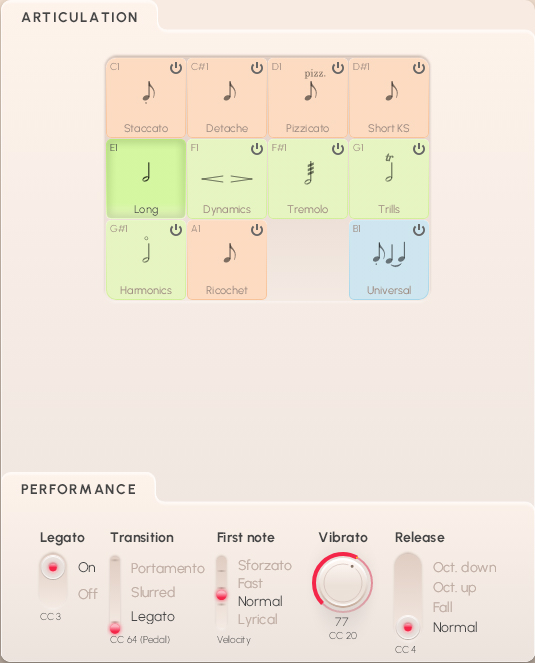
The Performance field contains all the playing variants of the selected articulation. So, depending on the number and type of variants, the performance options may look quite simple. There are up to five different parameters per articulation. Here’s a few examples:
The Legato option of long notes, trills, and others can be switched on and off with MIDI CC3.
Transition (MIDI CC64) defines the type of legato – e.g., regular, slurred, portamento –, and switches between regular and espressivo long notes when legato is off.
Type control for articulations is mostly set to keystroke velocity. For instance, it switches between different short note articulations, or to first note variants for legato phrases.
Some atriculations feature a Vibrato fader knob assigned to MIDI CC20, allowing you to “soft-switch” with a narrow crossfade area between samples without and with vibrato.
Release offers different release options with the help of MIDI CC4.
In the Sound pane, you can select a basic Category on the top left, and one of the Mixer Presets from that category on the right.
Mic Balance (MIDI CC61) adjusts the relation between intimate and ambient microphoning.
FX/Reverb (MIDI CC5) sets the amount of reverb, which is different in intensity according to the selected preset.
Output Volume (MIDI CC63) takes care of how much of what you do comes out of the Synchron Player.
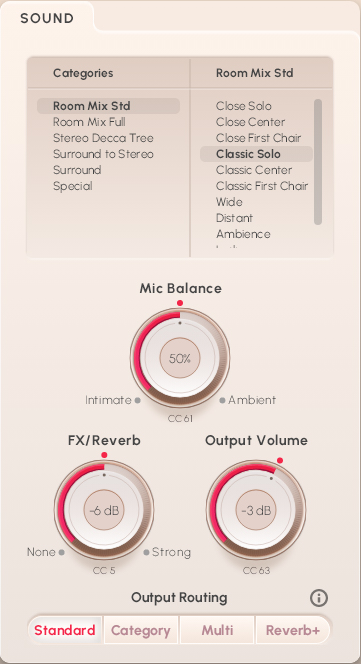
Finally, there is the choice of Output Routing represented by the four buttons Standard, Category, Multi, and Reverb+:
Standard is the standard Stereo configuration where all microphones are routed to the master output.
Category: here, only the ambient microphones are routed to the master output, while close microphones go to ouput 2,
Multi routes all microphones to different outputs.
Master out – Main, Room-Mix, Reverb
Output 2 – Main-Center
Output 3 – Surround
Output 4 – High-Surround
Output 5 – Mid
Output 6 – CloseReverb+ is routed like the Multi configuration, but has the Reverb channel routed to its own output 11.
If you’re not sure about the routing options, click on the information button next to the heading, which also provides graphic information on routing paths.
The Presets of the Collection comprise all the instruments’ recorded Patches in Articulation groups, which again contain Types of the respective Articulation, with further options if available. If you happen to be short of RAM, you can leave the entire dimension tree disabled and only enable the slots you need for your arrangement.
The Articulation keyswitches of violins and viola are mapped from C1 to A1 (for Middle C = C4), those of the cello from C1 to A#1. The Type keyswitches start from C2/F2 (depending on articulation) for the violins and viola, and from C6/F6 for the cello. The keyswitches for further options such as release and attack variants are mapped to the keyboard’s 7th octave.
Dimension Controllers offer additional options within some Articulations or Types, most notably that of crossfading between patches, and providing smooth transitions from, e.g., articulations with and without vibrato. The controller function is indicated by the respective caption, as of course it may take on different tasks as needed.
Articulations: violins, viola C1–A1; cello C1–A#1.
Type: violins, viola from C2/F2; cello from C6/F6.
Attack, release, other variants: starting at C7.
XF control: MIDI continuous controllers (CC).
Synchron libraries generally offer different Precision Presets according to how velocity is handled, arranged in separate folders.
“VelXF sus - MOD”: velocity crossfading is only activated for long notes, while the dynamics of short notes are controlled by keystroke velocity, thus facilitating phrasing. “VelXF - MOD”: all articulations have velocity crossfading activated so that you can control dynamics with MIDI controller CC1, the modwheel. “VelXF + Velocity control”: these Presets also use the modwheel, but in addition keystroke velocity is used to determine the attack behaviour of long notes, legato, etc. Moreover, there are special patch combinations, e.g., where velocity triggers spiccato or staccato samples. “Velocity”: note volume is controlled by keystroke velocity just like a piano.
Velocity crossfading can always be enabled or disabled by clicking its on/off symbol in the Synchron Player's Perform tab.
The Presets of each instrument group are subdivided into 9 (violins, viola) resp. 10 (cello) different Articulation categories:
Short notes
Long notes
Performance legato
Dynamics
Tremolo
Trills
Pizzicato
Harmonics
Effects (cello only)
Sequences
The new category “Sequences” presents a feature allowing you to play a pre-defined sequence of Articulations. The Articulation categories are further subdivided into Types such as spiccato or staccato, and additional options are available for most Articulations, e.g., attack or release variants.
Spiccato, staccato, détaché short/normal/soft/without vibrato, all with "bold" and "agile" attack variants; performance spiccato with normal and fast attack; détaché slides up and down; ricochet a1–a4; saltando; saltando glissando, up and down.
Type: C2–A#2 (violins, viola), C6–A#6 (cello, bass).
Bold / Agile, Up/Down: A7 / A#7.
Spiccato; staccato; détaché short, regular, soft, and without vibrato; saltando. All except saltando with bold and agile attack.
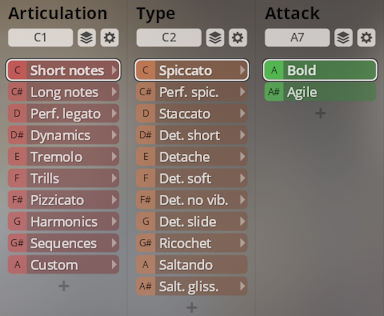
Performance spiccato with normal and fast attack, with an auto-speed option. Auto-speed uses Dim.Ctrl/B (playing speed) to determine attack behavior.
- Attack: A7/B7/C8.

In VelXF+Velocity control Presets, the change between normal and fast attack is controlled by keystroke velocity by default, so that no auto-speed cell is necessary.
Détaché slides, up, down, and fall; and glissando saltando, up and down.
- Up/Down: détaché A/–B7, glissando A7 / A#7.
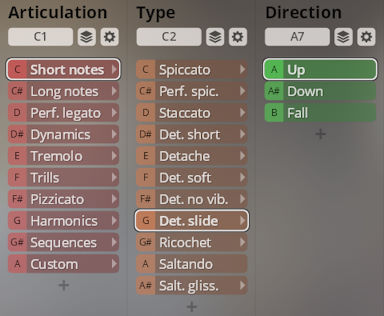
In VelXF+Velocity control Presets, the direction is controlled by keystroke velocity.
- Repetitions: F7–G#7.
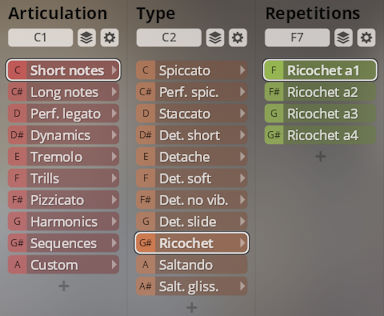
In the VelXF + Velocity Presets, the short notes have an additional Type named “Vel. control” with three sub Types that employ velocity control to switch between articulations: spiccato/staccato velocity control, détaché velocity control, and ricochet. Keystroke velocity is employed to trigger different patches.
- Type 2: F7–G7.
Spiccato/staccato, détaché
Use keystroke velocity to switch between spiccato/staccato resp. soft/normal/marcato détache.
- Articulation: Dim.Ctrl/C (keystroke velocity).
- Attack: A7/A#7.
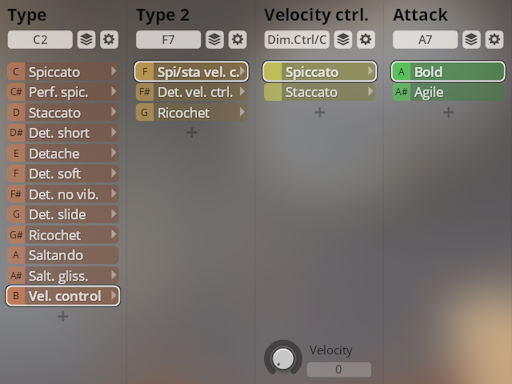
Ricochet
Keystroke velocity triggers ricochet a1–a3, and saltando.
- Repetitions: Dim.Ctrl/C (keystroke velocity).
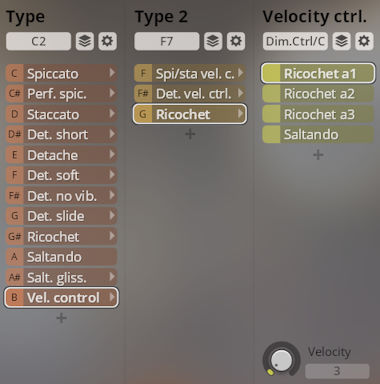
Sustained notes, regular with light, strong, and without vibrato, with attack and release variants; and slides, up and down, with release variants.
Regular/Slides: C2–C#2 (violins, viola), C6–C#6 (cello).
Long notes without, with light and strong vibrato, normal/soft/fast attack; with normal, fall, and octave up and down release.
Expression: G2–B2 (violins, viola), G6–B6 (cello).
Release: F7–G#7.
Attack: A7–C8.
In VelXF + Velocity control Presets, attack is controlled by keystroke velocity instead of keyswitches.
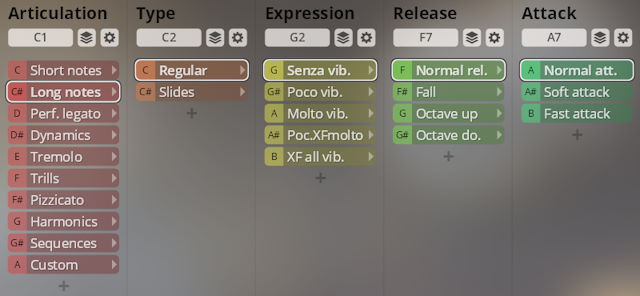
Vibrato XF poco/molto vibrato, all vibratos
Crossfading combination between poco and molto vibrato resp. all vibrato patches. Use Dim.Ctrl/A (CC20) for crossfading.
- Vibrato XFade: Dim.Ctrl/A (CC20).
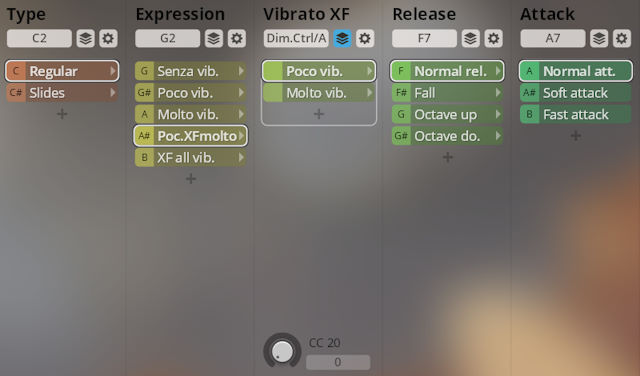
Attack: Dim.Ctrl/C (keystroke velocity).
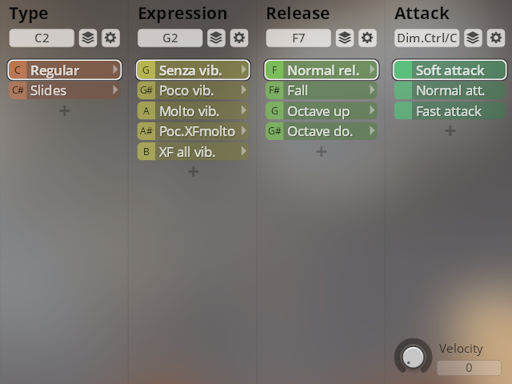
Slides, up and down, with normal, fall, and octave up and down release.
- Release: F7–G7.
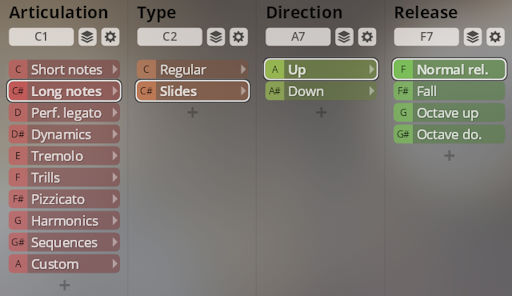
- Up/Down: Dim.Ctrl/C (keystroke velocity).
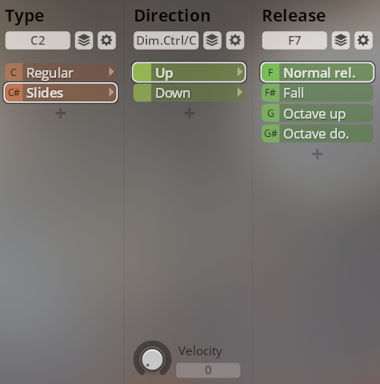
Legato normal and agile, slurred legato, and portamento, normal/soft/fast attack; lyrical legato, and zigane. All with normal, fall, and octave up and down release. Including an auto-speed option between normal and agile legato.
Type: C2–F#2 (violins, viola), C6–F#6 (cello).
Expression: G2–B2 (violins, viola), G6–B6 (cello).
Release: F7–G#7.
Attack: A7–B7.
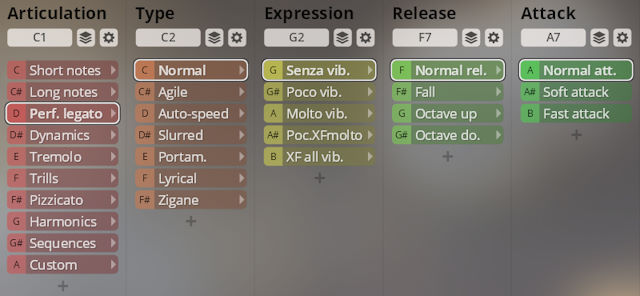
In VelXF + Velocity control Presets, attack is controlled by keystroke velocity instead of keyswitches.
Vibrato XF poco/molto vibrato, all vibratos
Crossfading combination between poco and molto vibrato resp. all vibrato patches. Use Dim.Ctrl/A (CC20) for crossfading.
Vibrato XFade: Dim.Ctrl/A (CC20).
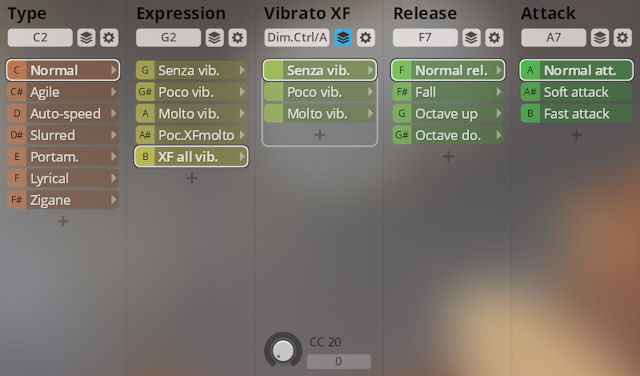
This option implements a controller on Dim.Ctrl/B to switch automatically between normal and agile legato according to playing speed.
- Speed controller: Dim.Ctrl/B (playing speed).
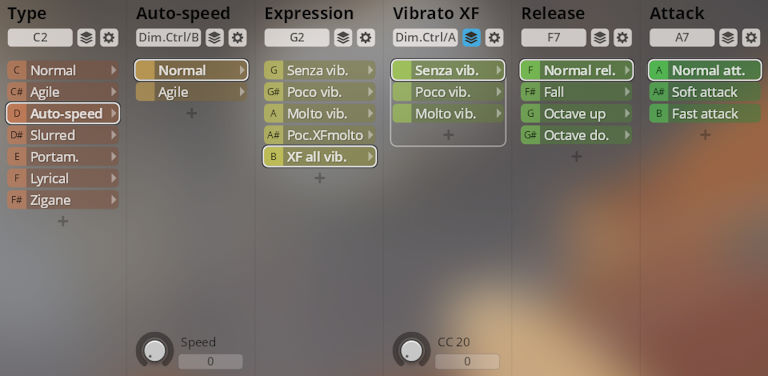
Lyrical legato and zigane with normal, fall, and octave up and down release.
- Release: F7–G#7.
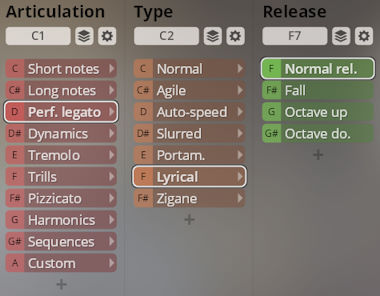
In these Presets, attack is controlled by keystroke velocity instead of keyswitches.
- Attack: Dim.Ctrl/C (keystroke velocity).
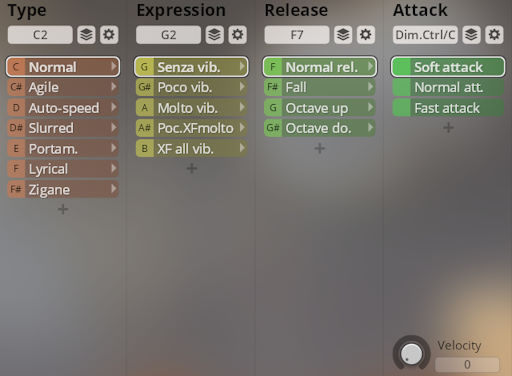
Sforzato, crescendo, diminuendo, piano to forte legato, and forte to piano legato.
Type: C2–E2 (violins, viola), C6–E6 (cello).
Transition: F7–G7.
Attack: A7/B7/C8.
In VelXF + Velocity Presets, attack is controlled by keystroke velocity instead of keyswitches.
Articulations with normal, fall, octave up and octave down release. The “legato” Patches differ from crescendo and diminuendo below in that only starting notes will play crescendo or diminuendo, while subsequent connected legato notes will stay in the target dynamic.
- Release: F7–G#7.
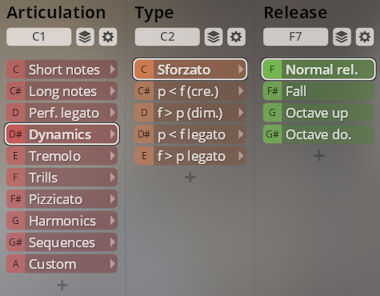
Short, medium, and long crescendo and diminuendo without and with vibrato.
Expression: G2–A2 (violins, viola), G6–A6 (cello).
Length: F7–G7.
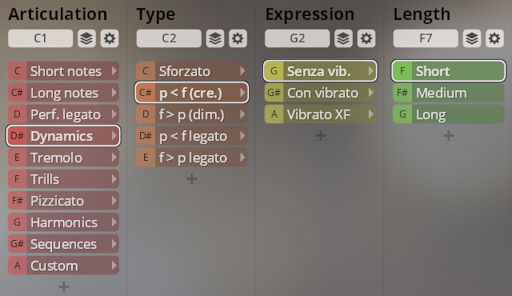
Vibrato XF
Crossfading option between senza and con vibrato with the help of Dim.Ctrl/A (MIDI CC20).
- Vibrato XFade: Dim.Ctrl/A (CC20).
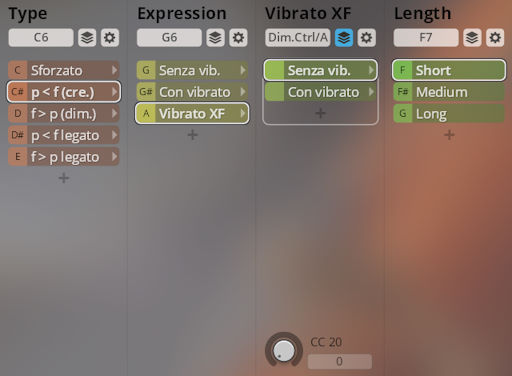
This additional cell in VelXF + Velocity control Presets switches between diminuendo and sforzato according to keystroke velocity.
Dim./sfz: Dim.Ctrl/C (keystroke velocity).
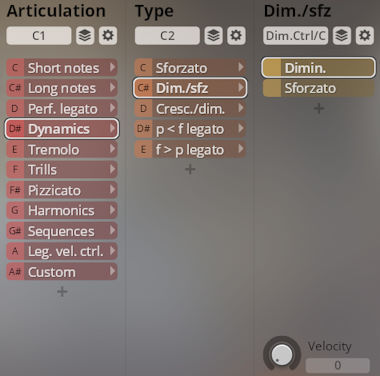
In VelXF + Velocity control Presets, crescendo and diminuendo are combined and can be controlled via keystroke velocity.
- Cres/dim: Dim.Ctrl/C (keystroke velocity).
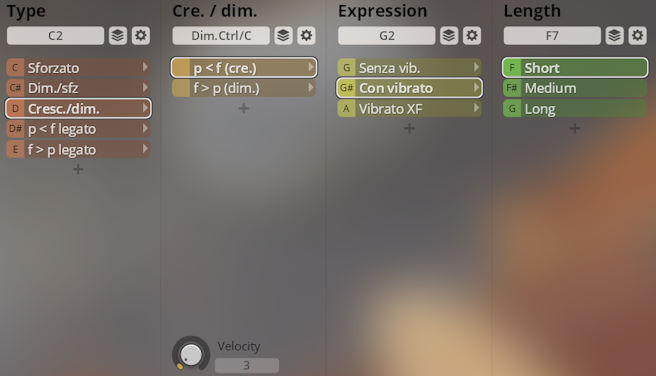
Tremolo with normal and legato transitions, and measured tremolo.
Type: C2–D2 (violins, viola), C6–D6 (cello).
In VelXF + Velocity Presets, attack is controlled by keystroke velocity instead of keyswitches.
Tremolo with normal and legato transitions, with normal and sforzato attack.
- Transition: F7–F#7.
- Attack: A7/B7.
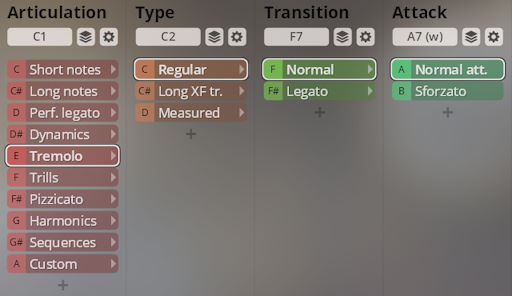
Use Dim.Ctrl/A (CC20) to crossfade between sustained notes and tremolo.
- Sustained/tremolo XFade: Dim.Ctrl/A (CC20).
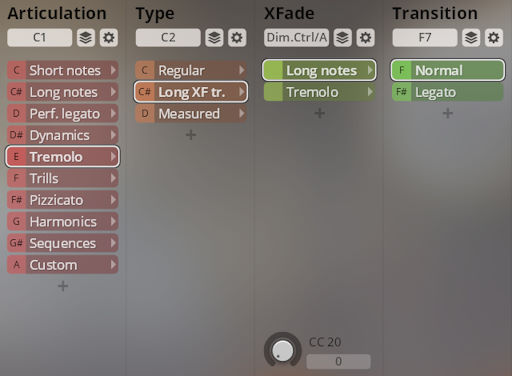
Tremolo at 120/130/140/160/180 bpm with normal and cut release.
Tempo: F2–A2 (violins, viola), F6–A6 (cello).
Release: F7/F#7.
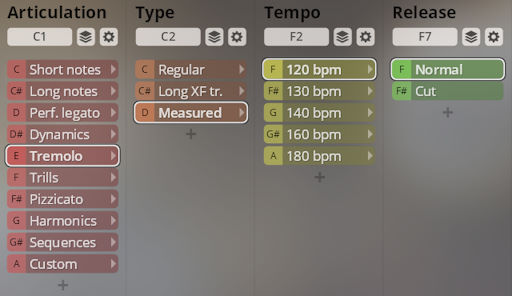
Trills, minor and major 2nd, with normal, legato, and slurred transitions.
Interval: F2–F#2 (violins, viola), F6–F#6 (cello).
Transition: F7–G7.
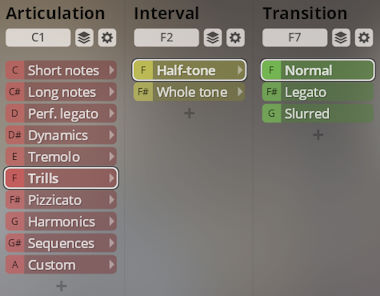
In VelXF + Velocity control Presets, the trills are controlled by keystroke velocity rather than by keyswitches.
Half/whole tone: Dim.Ctrl/C (keystroke velocity).
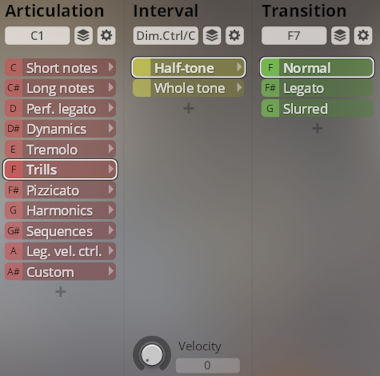
Pizzicato, bold and agile; snap pizzicato; col legno, bold and agile.
Type: C2–D2 (violins, viola), C6–D6 (cello).
Bold/agile: A7/A#7.
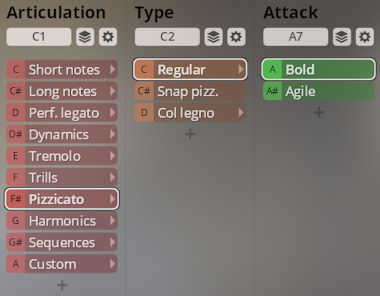
In this additional combination, Dim.Ctrl/C (keystroke velocity) is used to trigger regular pizzicato at lower velocities, and snap pizzicato at higher ones.
Regular/snap pizzicato: Dim.Ctrl/C (keystroke velocity).
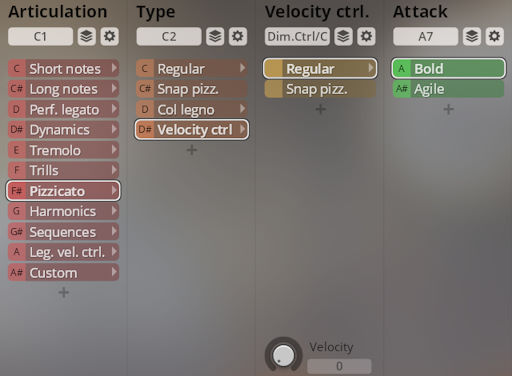
Harmonics sustained, tremolo, staccato and détaché bold and agile. With crossfading combinations of the long notes.
Type: C2–F#2 (violins, viola), C6–F#6 (cello).
In VelXF + Velocity control Presets, attack is controlled by keystroke velocity instead of keyswitches.
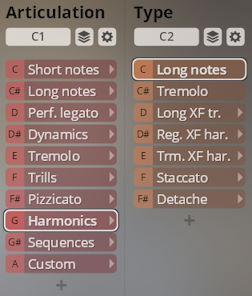
Crossfading combinations between sustained and tremolo harmonics, normal and harmonics sustains, and regular and harmonics tremolo. Use Dim.Ctrl/A (CC20) to crossfade between articulations.
- Articulation XFade: Dim.Ctrl/A (CC20).
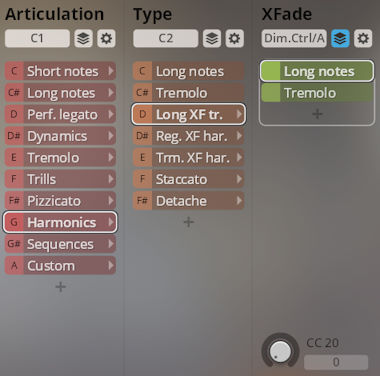
Staccato and détaché harmonics, bold and agile.
- Bold/agile: A7/A#7.
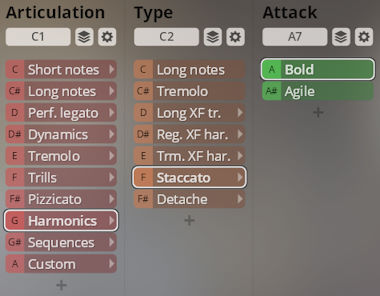
Scratches, glissando pizzicato, harmonics glissando, hammer, finger slides, and grabs.
- Type: C6–F6.
In VelXF + Velocity control Presets, the scratches’ length and finger slides’ direction are controlled by keystroke velocity instead of keyswitches.
Scratching strokes on the strings.
- Staccato/détaché: C7/C#7.
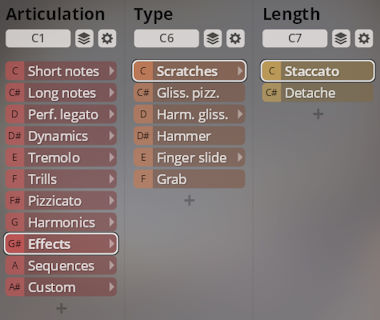
Pizzicato notes with subsequent upward glissandos.
- Range: C2–A4.
Harmonics glissandos on each string, slow and fast, up and down; and looped, with low and high release.
- Mapping: up/low release: C2, G2, D3, A3; down/high release: C4, G4, D5, A5.
- Slow/fast/loop: F7–G7.
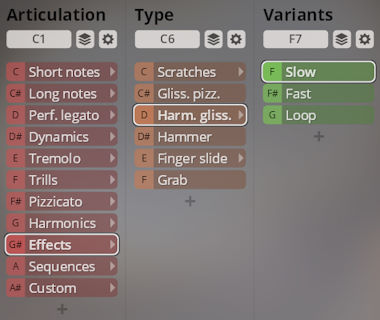
Hammering on the string with the finger to produce the tone.
- Range: D2–D5.
Producing noises by sliding a finger over the strings.
- Up/down: A7/A#7.
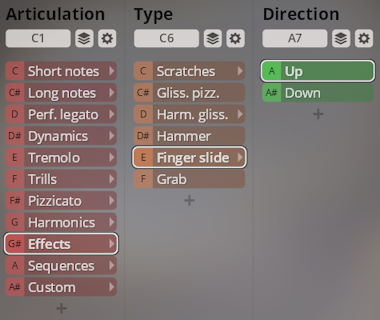
Grabbing and releasing the fingerboard with the strings in different places.
- Mapping: grab on: C2–B2; grab off: C4–B4.
This section is dedicated to sequences of two types of short articulations with 2 to 4 changes. The initial articulation ist followed by up to 3 repetitions of the other one.
Sequence type: C2–E2 (violins, viola); C6–E6 (cello).
Succession: F2–A#2; F6–A#6.
Bold/agile: A/A#7.
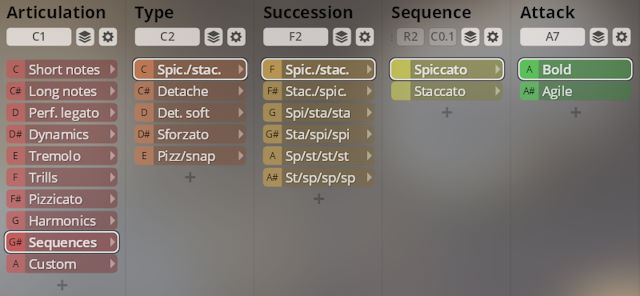
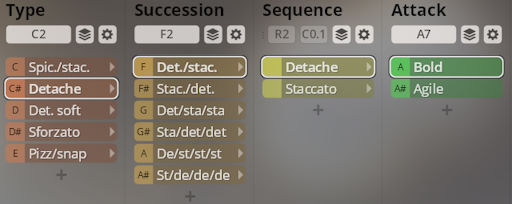
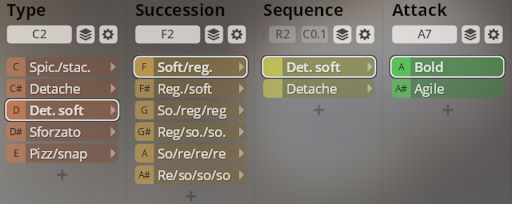

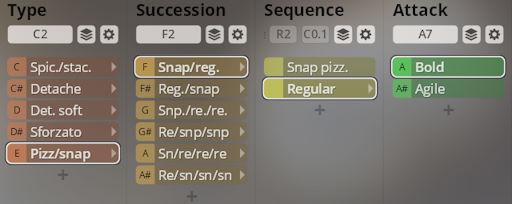
These Presets feature an additional Articulation where the legato type (normal, slurred, portamento) is controlled by keystroke velocity.
- Type: Dim.Ctrl/C (keystroke velocity).
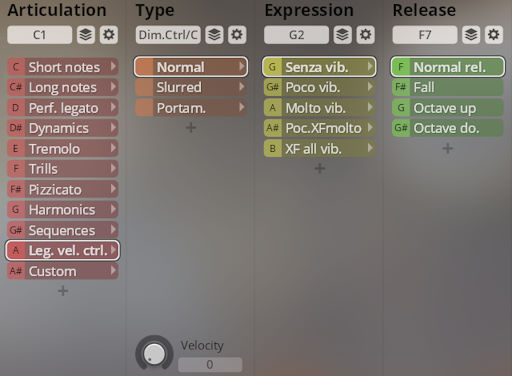
This “articulation” does not yet contain any patches. It provides 6 slots ready for you to configure presets of your own.
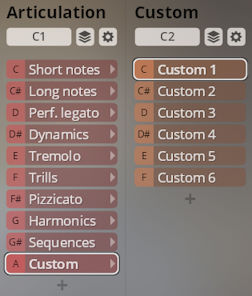
On this page
- Introduction
- Standard and Extended Library
- Patches
- Immersive Sound and Auro 3D
- Flow and Precision Presets
- Mixer Presets
- Flow Presets
- Instrument / Tone
- Articulation / Performance
- Sound
- Precision Presets
- Preset types
- Articulation categories
- Short notes
- Long notes
- Performance Legato
- Dynamics
- Tremolo
- Trills
- Pizzicato
- Harmonics
- Cello only: Effects
- Sequences
- VelXF + Velocity control – Legato vel.ctrl.
- Custom